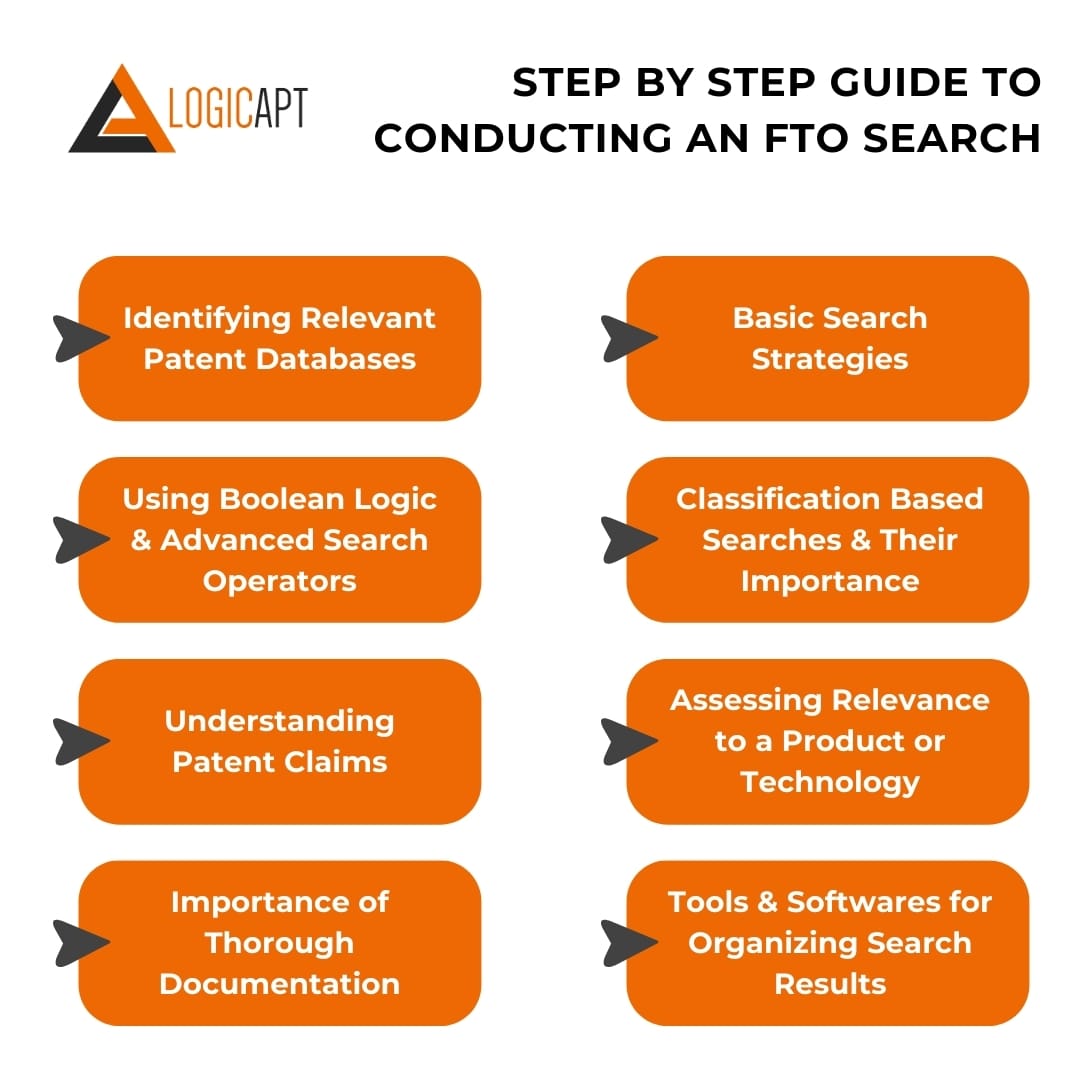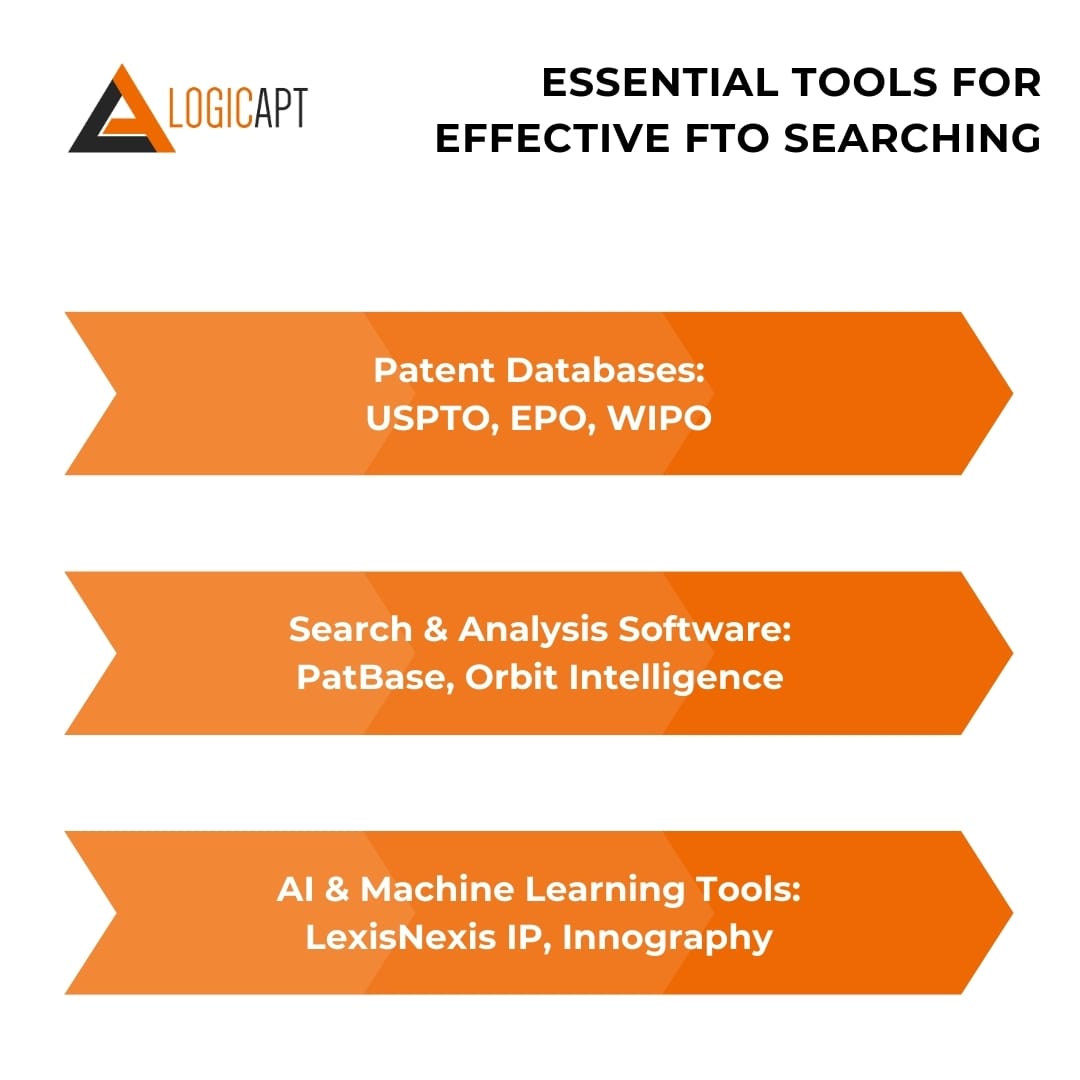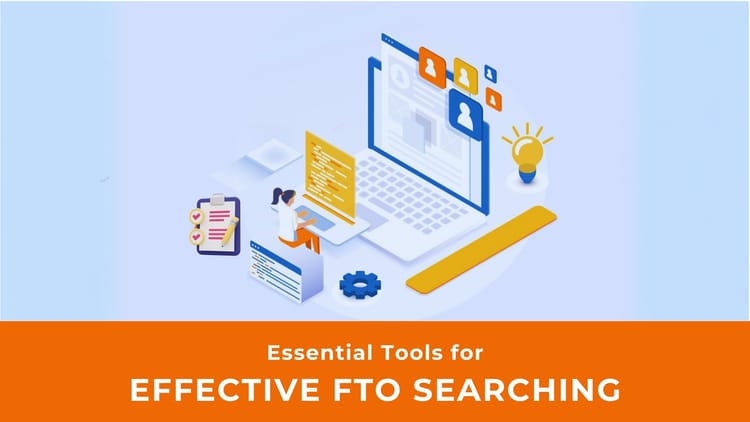Step-by-Step Guide for FTO Searches

Introduction: Navigating the Complexities of Freedom to Operate Searches
Understanding the Essence of FTO
Freedom to Operate (FTO) in intellectual property and innovation is a critical concept that often determines the trajectory of a new product or service. At its core, FTO ensures that your venture, whether a groundbreaking invention or a minor improvement to an existing product, doesn’t infringe on existing intellectual property rights, particularly patents.
The Critical Role of FTO Searches
Conducting an FTO search is not just a legal formality; it’s a strategic step that can safeguard your business against costly litigation and market entry delays. These searches provide insights into the patent landscape, helping you identify potential legal hurdles and navigate around them. More importantly, an FTO search can offer peace of mind, ensuring that your innovations stand on solid legal ground.
Preview of the Blog
This comprehensive guide will take a deep dive into FTO searches. We'll start with the basics: what FTO searches entail and why they are indispensable. Then, we'll guide you through a detailed, step-by-step process of conducting an effective FTO search, covering everything from initial patent searches to advanced techniques and tools. Along the way, we'll tackle common challenges and share industry best practices to ensure your FTO search is as thorough and efficient as possible. Whether you're a seasoned patent professional or new to the field of intellectual property, this guide is designed to equip you with the knowledge and tools necessary for mastering FTO searches.
Unraveling the Fundamentals of an FTO Search
Defining FTO Search
An FTO search, or Freedom to Operate search, is a diligent investigation conducted to ascertain whether a product, process, or service infringes upon the intellectual property (IP) rights of others, particularly patents. This search involves identifying and analyzing issued patents and pending patent applications to determine if a proposed product or process might infringe any existing patents.
The Purpose of FTO Searches
The primary goal of an FTO search is to mitigate the risk of patent infringement. It's a proactive measure to avoid legal disputes and financial liabilities before launching a new product or implementing a new process. FTO searches serve several purposes:
- Risk Assessment: They help in assessing the risk of potential patent infringement.
- Strategic Planning: They inform strategic decisions like entering new markets or developing new products.
- Legal Compliance: They ensure adherence to patent laws and regulations.
Legal and Business Implications of FTO
Legal Implications
- Infringement Avoidance: FTO searches are crucial for avoiding patent infringement, which can lead to lawsuits, hefty fines, and injunctions against selling a product.
- Legal Due Diligence: Conducting an FTO search demonstrates due diligence, which can be favorable in the eyes of the law if infringement issues arise.
- Licensing Opportunities: Identifying potential patent barriers early on can lead to licensing opportunities, allowing legal utilization of existing patents.
Business Implications
- Market Entry Strategy: FTO searches inform market entry strategies, indicating whether a new invention can be commercialized without legal obstacles.
- Investment and Funding: Clear FTO results can attract investors by minimizing the risks associated with patent infringement.
- Innovation Direction: They guide R&D efforts, steering development away from patented areas and towards innovation.
Laying the Groundwork for an FTO Search
Defining the Scope: Product, Process, or Service
Before diving into an FTO search, it’s crucial to clearly define the scope of what you're examining. This definition is the foundation upon which the entire search is built.
Identifying the Subject
- Product Analysis: If your focus is a product, detail its components, functionalities, and unique features. Understand how these elements might intersect with existing patents.
- Process Scrutiny: For a process, map out each step involved. Consider any novel methods or sequences that could infringe on patented processes.
- Service Evaluation: In the case of a service, delineate the operational aspects, techniques, or methods that are part of the service delivery.
Importance of Detail
- Granularity: The more detailed your understanding of the product, process, or service, the more effective your FTO search will be.
- Avoiding Overlooked Aspects: Paying attention to details ensures no aspect is overlooked, which could otherwise lead to unidentified patent infringements.
Understanding the Technological Field and Related IP
A thorough understanding of the relevant technological field is a prerequisite for an effective FTO search.
Technological Landscape Analysis
- Current Trends: Stay abreast of current trends and advancements in your technology sector. This knowledge helps in anticipating potential patent issues.
- Historical Context: A historical perspective on how the technology has evolved can provide insights into patent trends and potential gaps in the patent landscape.
Related Intellectual Property
- Patent Classifications: Familiarize yourself with the patent classifications related to your technology. This knowledge is crucial for efficient database searching.
- Existing Patents and Applications: Identify essential patents and applications in your field. Analyze them not just for potential infringements but also for insights into the state of innovation in your domain.
- Non-Patent Literature: Don’t overlook non-patent literature, such as scientific papers, which can provide context and background for your FTO search.
Learn more.
A Step-by-Step Guide to Conducting an FTO Search

Step 1: Initial Patent Search
Identifying Relevant Patent Databases
- Global Databases: Utilize international databases such as WIPO, USPTO, and EPO. These are critical for a broad search, especially for products with potential global reach.
- Regional Databases: For region-specific products, delve into national patent databases, like JPO (Japan) or KIPO (Korea).
Basic Search Strategies
- Keywords and Phrases: Develop a list of keywords and phrases related to your product, process, or service. Think broadly to cover all possible variations.
- Classification Codes: Use international patent classification (IPC) and cooperative patent classification (CPC) codes to filter results. These classifications help in narrowing down the search to relevant technological areas.
Step 2: Advanced Search Techniques
Utilizing Boolean Logic and Advanced Search Operators
- Boolean Operators: Learn to use AND, OR, and NOT to refine your search queries. This approach allows for a more targeted search.
- Advanced Operators: Familiarize yourself with operators like “NEAR,” “SAME,” and “WITH” for more precise results.
Classification-Based Searches and Their Importance
- Deep Dive into Classifications: Understand the nuances of classification codes to explore all relevant patents in your field.
- Combining Classifications: Sometimes, combining different classification codes can reveal patents that a simple keyword search might miss.
Step 3: Analyzing Search Results
Understanding Patent Claims
- Claim Interpretation: Focus on the claims of each patent as they define the legal boundaries of the patent.
- Infringement Potential: Assess if your product or process potentially falls within these claims.
Assessing Relevance to Your Product or Technology
- Relevance Filtering: Not all identified patents will be relevant. Filter out patents that don’t pose a direct infringement risk.
- Patent Status: Check relevant patents' legal status (active, expired, application) to understand their enforceability.
Step 4: Documenting Your Search
Importance of Thorough Documentation
- Legal Safeguard: Detailed records of your search process and findings can be crucial in legal contexts, demonstrating due diligence.
- Future Reference: Documentation is a reference for future developments or additional searches.
Tools and Software for Organizing Search Results
- Patent Management Software: Utilize software tools designed for patent analysis and management. These tools can help organize, categorize, and store search results efficiently.
- Collaboration Tools: If working in a team, use collaboration tools to share findings and insights effectively.
Essential Tools for Effective FTO Searching
Efficient and thorough FTO searches rely heavily on the tools used. This section reviews essential tools that aid the FTO search process, from patent databases to cutting-edge AI technologies.

Tool Type 1: Patent Databases
Overview of Key Patent Databases
- USPTO (United States Patent and Trademark Office): Ideal for U.S. patents. It offers comprehensive data and a user-friendly interface.
- EPO (European Patent Office): Covers European patents. Known for its extensive database and advanced search capabilities.
- WIPO (World Intellectual Property Organization): Provides global patent information. Essential for international FTO searches.
Pros and Cons of Each
- USPTO:
- Pros: Extensive database, frequent updates.
- Cons: Primarily U.S.-focused, less effective for global searches.
- EPO:
- Pros: Broad coverage, including non-European patents.
- Cons: Complexity in search functionality may require a learning curve.
- WIPO:
- Pros: Global coverage, proper for multi-country searches.
- Cons: It may need to be more detailed for regional patent information.
Tips for Effective Use
- Utilize Advanced Search Features: Each database has unique advanced search features. Familiarize yourself with these to maximize search efficiency.
- Regular Updates: Stay updated with these databases' latest additions and changes.
Tool Type 2: Search and Analysis Software
Review of Software Tools
- PatBase: Offers a comprehensive collection of patent documents with strong search and analysis features.
- Orbit Intelligence: Known for its deep analytics capabilities and user-friendly interface.
Features to Look For
- Search Flexibility: Look for software that offers advanced search options and flexibility in query building.
- Data Visualization: Tools that provide data visualization can help understand the patent landscape more effectively.
How They Aid in FTO Searches
- Efficiency: These tools can significantly speed up the search process.
- Accuracy: Advanced algorithms help reduce the risk of missing relevant patents.
Tool Type 3: AI and Machine Learning Tools
The Role of AI in Revolutionizing FTO Searches
AI and machine learning are changing the game in FTO searches by automating complex tasks and providing predictive insights.
Examples of AI Tools and Their Capabilities
- LexisNexis IP (formerly known as Lex Machina): Uses AI to analyze legal data, helping predict patent litigation trends.
- Innography: Offers advanced analytics and visualization tools powered by AI for comprehensive IP research.
Navigating Challenges in FTO Searches
FTO searches are fraught with complexities and challenges. Recognizing these obstacles and understanding how to overcome them is crucial for a successful FTO search. This section discusses common hurdles encountered during FTO searches and provides strategies and real-world case examples to navigate these challenges effectively.
Identifying and Overcoming Typical Hurdles
Challenge 1: Overwhelming Volume of Data
- Problem: The sheer volume of patents can be daunting, making it challenging to identify relevant information.
- Solution: Use advanced search filters and AI-powered tools to narrow down search results. Focus on classifying patents according to relevance and current legal status.
Challenge 2: Keeping Up with Rapid Technological Changes
- Problem: Rapid innovation, especially in tech-driven industries, can render patent information outdated quickly.
- Solution: Regularly update your search criteria and stay informed about the latest developments in your field. Utilize AI tools for real-time updates.
Challenge 3: Global Patent Variations
- Problem: Differences in patent laws and documentation across countries complicate international FTO searches.
- Solution: Consult with international IP experts and use global databases like WIPO for comprehensive coverage.
Challenge 4: Interpreting Complex Legal Language
- Problem: Patent documents often contain complex legal and technical language that can be difficult to interpret.
- Solution: Collaborate with patent attorneys or legal experts for accurate interpretation. Training in legal terminology can also be beneficial.
Case Examples of Overcoming Search Challenges
Case Study 1: Addressing Data Overload in the Pharmaceutical Industry
- Scenario: A pharmaceutical company faced difficulty sifting through thousands of patents while researching a new drug.
- Approach: Implemented a combination of AI-powered search tools and expert reviews to filter and prioritize relevant patents efficiently.
- Outcome: Streamlined the search process, focusing on high-risk patents and significantly reducing research time.
Case Study 2: Navigating International Patents in Renewable Energy
- Scenario: A renewable energy startup planned to expand its operations into Europe and Asia, requiring a comprehensive understanding of diverse patent landscapes.
- Approach: Engaged with regional IP consultants and utilized global patent databases for localized searches.
- Outcome: Successfully identified potential IP conflicts and adjusted their market entry strategy accordingly.
Best Practices in FTO Search
Adhering to best practices is key to ensuring that your Freedom to Operate searches are thorough and effective. This section compiles essential guidelines and expert tips that can enhance the quality and efficiency of your FTO searches.

Summarizing Key Best Practices
Comprehensive and Systematic Approach
- Start with a Broad Scope: Initially cast a wide net in your searches to ensure no potential patent is overlooked.
- Refine Your Search Gradually: Narrow the results step by step, focusing on more specific aspects relevant to your product or technology.
Regular Updates and Monitoring
- Stay Current: Regularly update your search to include new patent filings and legal developments.
- Set Up Alerts: Use tools that provide alerts for new patents or changes in existing patents in your field.
Collaborate with Experts
- Seek Expert Insights: Engage with patent attorneys or FTO specialists for their expertise, especially for interpreting complex patents and legal nuances.
- Cross-functional teamwork: Involve team members from legal, technical, and business backgrounds to provide a comprehensive perspective.
Utilize Advanced Tools and Technologies
- Leverage AI and Machine Learning: Incorporate advanced tools that utilize AI and machine learning for more efficient and accurate searches.
- Data Management Software: Use software for organizing and managing search results effectively.
Tips from Industry Experts
Prioritize Quality Over Quantity
- Focus on Relevance: Identifying critical patents that pose a real risk is more important than gathering many loosely related patents.
Understand the Legal Landscape
- Stay Informed: Keep abreast of changes in patent laws and IP regulations, as these can directly impact your FTO strategy.
Be Proactive
- Anticipate Future Developments: Consider where the technology is heading and how future innovations might affect your FTO.
Document Meticulously
- Keep Detailed Records: Maintain thorough documentation of your search process and findings, as these can be vital in legal scenarios.
Conclusion: Mastering the Art of FTO Searches
As we conclude this comprehensive guide on Freedom to Operate (FTO) searches, we must reflect on our journey to understand FTO’s importance and intricacies. From defining an FTO search to exploring advanced tools and best practices, we’ve delved deep into intellectual property and its impact on innovation and business strategy.
The Importance of FTO Searches
FTO searches are a legal requirement and a strategic necessity in today’s fast-paced and innovation-driven market. They provide crucial insights into the patent landscape, helping businesses and innovators to:
- Avoid costly patent infringement litigations.
- Navigate the complex web of existing patents.
- Make informed decisions about product development and market entry.
The Intricacies of FTO Searches
Through this guide, we've seen that FTO searches involve much more than a mere glance at patent databases. They require:
- A systematic approach to defining the scope and conducting searches.
- A deep understanding of the technological field and related intellectual property.
- Utilization of advanced tools and technologies to enhance search efficiency and accuracy.
- Regular updates and proactive strategies to stay ahead of the curve.
Staying Informed and Utilizing Best Practices
The world of patents and FTO is ever-evolving, with new technologies and legal developments continuously shaping the landscape. Staying informed and adaptable is key. Regularly updating your knowledge and skills and utilizing the best practices outlined in this guide will ensure that your FTO searches remain effective and relevant.
Final Encouragement
We encourage you to embrace the complexity of FTO searches as an opportunity to innovate and strategize effectively. Whether you’re a budding entrepreneur, a seasoned patent attorney, or a business leader, mastering FTO searches is critical to navigating the modern business world. Use the insights and strategies this guide shares to protect your innovations, comply with legal requirements, and pave the way for successful market entries.
Remember, knowledge is power in the realm of intellectual property. Stay curious, stay informed, and use the power of effective FTO searches to drive your business and innovations forward.




